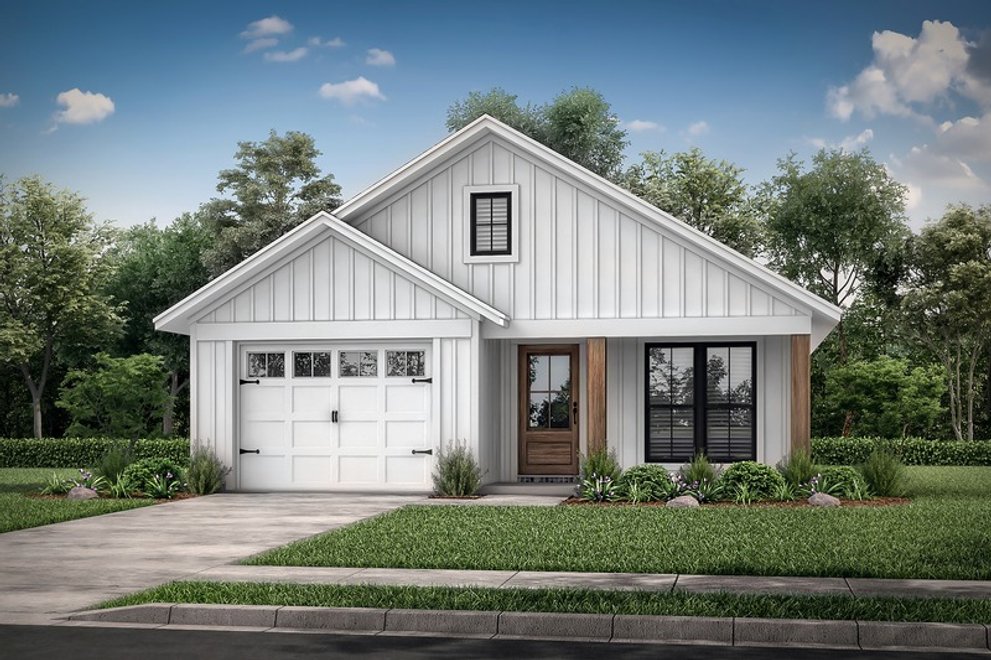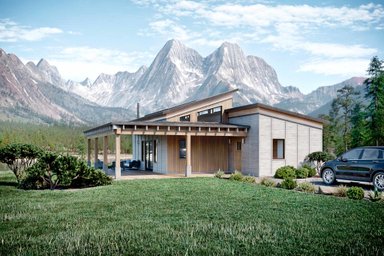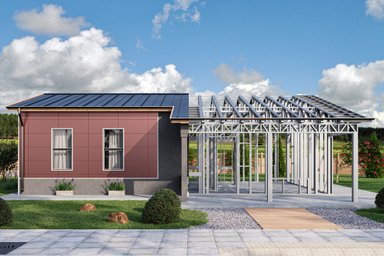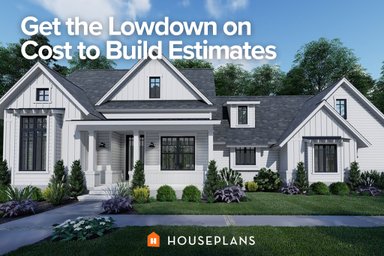.By Jenny Clark
Discover 16 answers to frequently asked questions related to home plans and building your own house.
Do I need an architect to draw plans?
No. In fact, it’s often easier and cheaper to select a pre-drawn house plan from a website like HousePlans.com.
What size are house plans?
Our most popular house plans tend to be between 1,500 and 2,500 sq. ft. Architectural plans are printed in common paper sizes denoted by "ARCH (LETTER)." The most common paper size is ARCH D (24 x 36 in.), although larger and smaller sizes are also possible.
Is it cheaper to build a 2 story house?
It depends. 2 story houses have the potential to cost less, as they typically require less foundation and roofing work. That said, a lot of factors contribute to the cost of building a house, like building location, build quality, and the size, layout, and details of the house plan you choose to build from. Think about it like this: if cost were not a factor, would you want a single story house or a two story home? Once you have that answer, tell your home builder, "This is what I want. Now, how do I keep building and maintenance costs down?" What’s more, shop around and see what kind of land is available in your desired build location. For example, if you want to live in Location X, but Location X only has lots that are 25 feet wide, you’ll probably want to select a 2 or 3 story home plan, as most single story designs aren’t gonna fit!
How much do house plans cost?
On average, you can expect to spend between $1,100 and $1,300 on a home plan. Note: we offer a low price guarantee so you can shop with confidence.
Is it cheaper to buy or build a house?
In general, it’s cheaper (at least, up front) to buy a home than it is to build one. That said, there are pros and cons connected to both. See examples below.
-
Building PRO: Perfection. Building a brand new home from a house plan gives you the opportunity to get the exact layout, square footage, and amenities you want from the outset. (Fun fact: nearly all of our home plans can be customized. Therefore, even if you can’t find a pre drawn floor plan that’s 100% perfect, you'll likely be able to modify a nearly perfect design so it becomes your dream home.)
-
Building CON: Upfront costs will likely be higher. According to HomeAdvisor.com, building a home typically costs between $150,635 - $444,315 (with homeowners reporting that "the average cost to build a new house comes in at $296,828"). Meanwhile, the median home sale price is $237,000," according to Zillow, as of August 31, 2019. Please note that home buying and home building costs vary greatly depending on your location, material choices, etc.
-
Building PRO: Everything’s new! Brand new homes typically need fewer repairs than older, existing homes.
-
Building CON: Time. Building your own home takes longer than buying an existing property.
-
Building PRO: Glory. While lots of people can brag that they bought "a house," only super-cool people get to say they BUILT their DREAM home!
What is the best website for house plans?
HousePlans.com is the best. Why? Because we offer a massive inventory of house blueprints, many of which are designed by world renowned architects. We also proudly present top notch customer care, home plan modification services, cost to build reports, and competitive pricing. Whether you're looking for a simple home plan, a luxury house plan, or something in between, we're sure to have the design that's right for you. Take note: we also feature duplexes and multi family house plans, as well as garages, garage apartment plans, and more. Call 1-800-913-2350 for more info.
What is the best home design?
Open floor plans are especially popular, as they provide an open sight line from the kitchen to the main living area. Homeowners tend to appreciate this design type, as it allows the chef of the house to maintain contact with children and guests as they prepare meals and snacks. That said, there is no official "best home design," as everyone has different tastes and requirements.
What plans are needed to build a house?
To build a house, you’ll need construction plans. When you order a set of plans from us, your package will usually include exterior elevations, floor plan(s), foundation plan and footings, roof plan, building sections and details, electrical plans, and construction notes and details page(s). Ask your home builder and building department if there are other necessary requirements for your specific project and area. For example, you might need:
-
A stamp - stock plans (like those presented on HousePlans.com) do not have a professional stamp attached. If your building department requires one, they will only accept a stamp from a professional licensed in the state where you plan to build. In this case, you will need to take your home plans to a local engineer or architect for review and stamping. What's more, if you intend to build a home in Nevada, your home plans must be drawn by a licensed Nevada architect, as required by law.
-
A site plan, which shows where the house will be located on the property
-
Beams sized to accommodate roof loads specific to your region
-
A septic design, assuming your lot is not served by a sanitary sewer system
-
To comply with area-specific energy codes
-
A state licensed structural engineer to analyze your house design and provide additional drawings and calculations, assuming you’re building in a location that has strict engineering rules, like Florida (hurricanes) or California (earthquakes).
Do you need blueprints to build a house?
Yes. House blueprints (also called "house plans," "home plans," "floor plans," etc.) are needed to build a house.
How do I make a floor plan?
Unless you’re a professional architect or house plan designer, creating your own house blueprints is not advised. That said, if you have an idea of what you would like to see in a house plan, feel free to draw it out as best you can (you can literally do this on a napkin). Then, send us the drawing and let us help you turn it into a professional house blueprint.
What is a typical floor plan?
While house floor plans come in all shapes, sizes, and styles, our especially popular floor plans tend to be between 1,500 and 2,500 sq. ft. Hot design elements include: one or two stories of living space, open floor plans, main level master suites, spa-like master baths, inlaw suites, Jack and Jill baths, outdoor living areas, and mudrooms with storage. With regard to architectural styles, Craftsman and modern farmhouse are by far the trendiest.
Who makes blueprints for houses?
Architects and house plan designers create blueprints for houses. If you’re planning to build your own home, we suggest going to a site like HousePlans.com and selecting a pre drawn design, as this is often easier and cheaper than going to an architect or designer and having them draw a new plan from scratch. If you can’t find a pre drawn house blueprint that meets all of your needs, ask us about customization (almost all of our house designs can be modified to meet your requirements). Common home plan modifications include: adding or removing a bedroom or bathroom; changing the foundation, framing, footprint, or roof pitch; expanding the garage; and just about anything else you can think of. Learn more about home plan modifications here
How can I save money when building a house?
-
Keep it simple - select a small house plan to build from that sports a simple footprint and straightforward interior design.
-
Location, location, location - Choose a relatively inexpensive building location (typically, big cities and coastal areas tend to be more expensive than rural and suburban locations). What’s more, make sure your home builder reviews and signs off on your lot BEFORE you buy it.
-
Get a cost to build report for the house plan you intend to purchase so you know upfront what costs will likely be involved. FYI: you can purchase a cost to build report for any design you see on HousePlans.com.
-
Make smart choices – Select economical materials that look nice but that don’t break the bank. Furthermore, ask your builder if you can utilize re-claimed/used materials (check to see if there's a Habitat for Humanity in your area).
-
DIY - If you have experience in specific areas, such as painting, landscaping, doing electrical work, etc., ask your home builder when/where you can pitch in to save on labor costs.
-
Hire a good home builder who is familiar with your building location. Read Dream Home Source's: "How to Find a Home Builder" blog.
-
Make decisions on-time and stick with them. For example, if your builder needs to know your choice of flooring in the master suite by next week, make sure you meet that deadline. What’s more, don’t change your mind about color, material, etc. after the flooring (or anything else) has already been ordered or installed.
-
Go green – ask your home builder how to make your home as energy efficient as possible to save on heating, cooling, and lighting costs down the road.
-
Select a pre drawn home plan from a site like ours, as this is often cheaper than asking an architect or designer to create a plan from scratch.
Is it a good idea to buy land and build a house?
Yes! Read our "Is it a good idea to buy land and build a house?" blogto learn more.
Is a 1000 sq ft house small?
Most people would consider a 1,000 sq. ft. home to be small. On the other hand, everything’s relative. For instance, if you’re moving into a 1,000 sq. ft. home from a 300 sq. ft apartment, 1,000 sq. ft. might feel pretty darn big!
What states allow tiny houses?
Note that building rules and regulations can be different in different parts of a state. For the best and most up-to-date information on your specific area, we suggest contacting your local planning/zoning department. Explain to them exactly where you want to build your tiny house. Furthermore, describe what kind of tiny house you intend to build (e.g. will it have a foundation or will it be on wheels?), and how much square footage your tiny home will feature (your definition of “tiny” might not match theirs). Finally, if the neighborhood you plan to build in boasts an HOA (Home Owners Association), we recommend contacting them as well.
Have more questions? Check out our main FAQ page or call 1-800-913-2350 to speak directly with an experienced Plan Adviser. To search for home plans, click here.






